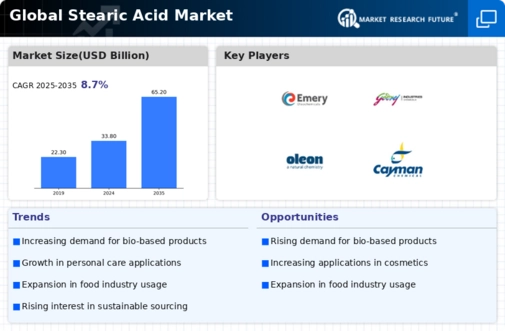Market Share
Stearic Acid Market Share Analysis
Market share positioning strategies in the Stearic Acid Market are crucial for companies aiming to establish a strong foothold and maximize their presence in the industry. These strategies encompass various approaches to gaining a competitive advantage and capturing a significant portion of the market share. One such strategy is differentiation, where companies emphasize unique features or qualities of their stearic acid products to set themselves apart from competitors. This could involve highlighting superior quality, purity, or sustainability practices in production processes, which appeal to environmentally conscious consumers or those seeking higher performance. By differentiating their offerings, companies can carve out a distinct market niche and attract customers who value these specific attributes.
Growing personal care industry as a result of increased spending on the cosmetics and skin & hair care products.
Another essential strategy is pricing, wherein companies strategically set their prices to attract customers while also maintaining profitability. This could involve offering competitive prices compared to rival products or implementing pricing strategies such as penetration pricing to quickly gain market share. Alternatively, companies may opt for a premium pricing strategy if they position their stearic acid as a high-end product with superior quality or additional benefits. Pricing strategies are often tailored to target specific market segments, considering factors such as purchasing power, price sensitivity, and perceived value among customers.
Furthermore, distribution channels play a vital role in market share positioning strategies. Companies need to ensure their products are readily available to customers through efficient distribution channels. This may involve establishing partnerships with distributors, wholesalers, or retailers to reach a broader customer base. Additionally, companies may invest in developing an online presence and e-commerce platforms to capitalize on the growing trend of online shopping. By expanding distribution channels and improving accessibility, companies can increase their market reach and gain a competitive edge over rivals with limited distribution networks.
Effective marketing and promotional activities are also integral to market share positioning strategies in the Stearic Acid Market. Companies invest in targeted marketing campaigns to raise awareness about their products, educate consumers about their benefits, and influence purchasing decisions. This could include advertising through various channels such as print media, television, digital platforms, and social media. Additionally, companies may engage in promotional activities such as discounts, coupons, or loyalty programs to incentivize purchases and foster customer loyalty. By implementing strategic marketing initiatives, companies can enhance brand visibility, generate demand for their products, and ultimately expand their market share.
Moreover, innovation and product development play a significant role in market share positioning strategies. Companies invest in research and development to create innovative stearic acid formulations that address evolving customer needs and preferences. This could involve developing environmentally friendly or sustainable products, introducing new formulations tailored for specific applications, or improving product performance and efficiency. By continuously innovating and offering differentiated products, companies can stay ahead of competitors, attract new customers, and retain existing ones, thereby strengthening their market position.







Leave a Comment